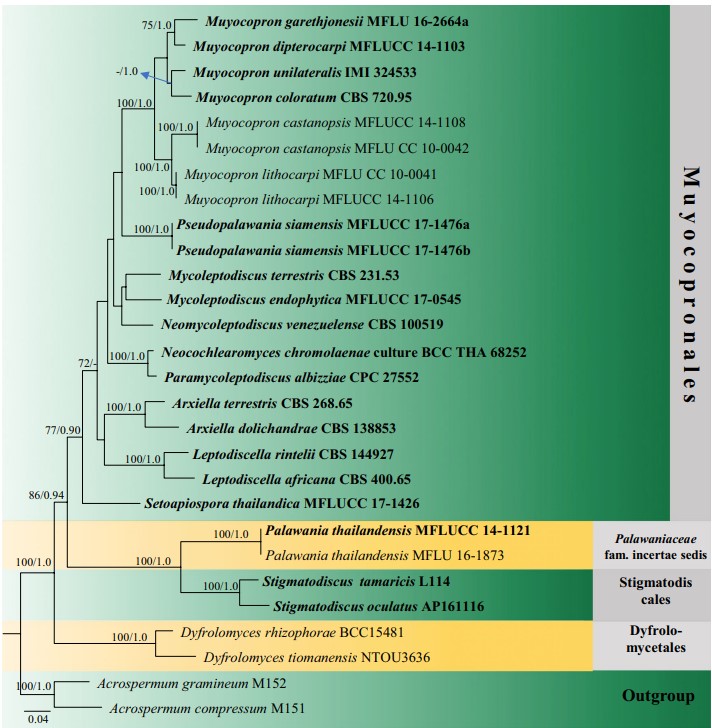Muyocopronaceae K.D. Hyde, in Hyde et al., Fungal Diversity 63: 164 (2013).
MycoBank number: MB 804506; Index Fungorum number: IF 804506; Facesoffungi number: FoF 08090, 68 species.
Saprobic, common on the surface of dried twigs, stems and less common on leaves, appearing as black spots, mycelium absent. Sexual morph: Ascomata superficial on host surface, circular, scattered, flattened, rarely coalescing, carbonaceous and coriaceous, black, with a poorly developed basal layer, with a central irregular ostiole, lenticular when section. Upper wall irregularly arranged radiating cells, branched at margin cells. Peridium 2-layered, an outer layer comprises brown to black pseudoparenchymatous of compact thick-walled textura epidermoidea cells, light brown of textura angularis cells at inner layer. Hamathecium comprising dense, septate, cellular pseudoparaphyses which are longer than the asci and immersed in mucilage and inclined towards the centre. Asci 8-spored, bitunicate, fissitunicate, pedicellate, with small ocular chamber. Ascospores 2–3-seri- ate, ellipsoidal to ovate with obtuse ends, hyaline, aseptate, with or without granular appearance. Asexual morph: See Papendorf (1967), Crous et al. (2016b, 2018a), Hernández-Restrepo et al. (2019).
Type: Muyocopron Speg.
Notes: Muyocopronaceae was invalidly introduced by Luttrell (1951), and was synonymized under Microthyriaceae (Wu et al. 2011a, b). Hyde et al. (2013) accepted and formally introduced Muyocopronaceae as a distinct family, as well as provided an English diagnosis (Latin diagnosis no longer required). Phylogenetic analyses indicated that the family, Muyocopronaceae comprises nine genera Arxiella, Leptodiscella, Mycoleptodiscus, Muyocopron, Neocochlearomyces, Neomycoleptodiscus, Paramycoleptodiscus, Setoapiospora, and Pseudopalawania (Mapook et al 2020; this study, Fig. 56)

Fig. 56 Phylogram generated from maximum likelihood analysis (RAxML) of Muyocopronales based on ITS, LSU, rpb-2, SSU and tef1 sequence data. Maximum likelihood bootstrap values equal or above 70%, Bayesian posterior probabilities equal or above 0.90 (MLBS/PP) are given at the nodes. An original isolate number is noted after the species name. The tree is rooted to Acrospermum compressum (M151) and A. gramineum (M152). The ex-type strains are indicated in bold. Hyphen (-) represents support values below 70% MLBS and 0.90 PP
Genera
